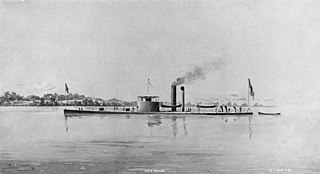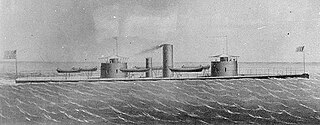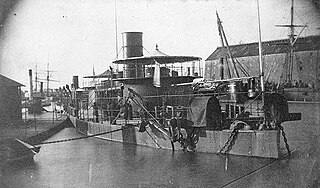
The first USS Rhode Island was a side-wheel steamer in the United States Navy, commissioned in 1861.

The first Passaic was a single turreted, coastal monitor purchased by the United States Navy for service during the American Civil War.
USS Napa was a Casco class twin-screw light draft monitor built during the American Civil War for operation in the shallow inland waters of the Confederacy. These warships sacrificed armor plate for a shallow draft and were fitted with a ballast compartment designed to lower them in the water during battle.

USS Monadnock was one of four Miantonomoh-class monitors built for the United States Navy during the American Civil War. Commissioned in late 1864, she participated in the First in December and Second Battles of Fort Fisher in January 1865. The ship was later assigned to the James River Flotilla on the approaches to the Confederate capitol of Richmond, Virginia and then sailed to Spanish Cuba to intercept the Confederate ironclad CSS Stonewall.

The first USS Casco was the first of a class of twenty 1,175-ton light-draft monitors built by Atlantic Works, Boston, Massachusetts for the Union Navy during the American Civil War.
The first USS Tunxis was launched on 4 June 1864 at Chester, Pennsylvania, by Reaney, Son & Archbold; and commissioned at the Philadelphia Navy Yard on 12 July 1864. On 21 September 1864, the light-draft monitor departed the sheltered waters of the navy yard on her maiden voyage. However, she soon began taking on water at such an alarming rate that she came about and returned to Philadelphia where she was decommissioned later in the month.
USS Umpqua, a single-turreted, twin-screw monitor, was laid down in March 1863, before the official order had been placed, at Brownsville, Pennsylvania, by Snowden & Mason; launched on 21 December 1865; and completed on 7 May 1866.
USS Waxsaw, a single-turreted, twin-screw monitor, was laid down in March 1863, before the official order had been placed, at Baltimore, Maryland, by A. & W. Denmead & Son; launched on 4 May 1865; and completed on 21 October 1865.
USS Suncook – a single-turreted, twin-screw monitor – was built by the Globe Works, South Boston, and delivered to the government at the Boston Navy Yard on 8 July 1865.
USS Shiloh was a single-turreted, twin-screw monitor that was slated to enter service with the United States Navy. The contract for her construction was awarded on 24 June 1863 to George C. Bestor of Peoria, Illinois. Her keel was laid down later that year at the yard of Charles W. McCordat of St. Louis, Missouri. However, while Shiloh was still under construction, USS Chimo, one of the first of the Casco-class monitors to be launched, was found to be unseaworthy.
USS Klamath — a single-turreted, twin-screw monitor of the United States Navy — was launched 20 April 1865 by S. T. Hambleton & Co., Cincinnati, OH, under subcontract with Alexander Swift & Co., also of Cincinnati, OH. She was delivered to the Navy on 6 May 1866 but was never commissioned and saw no service.
USS Koka—a single-turreted, twin-screw monitor—was launched 18 May 1865 by Wilcox & Whiting, Camden, New Jersey. She was a Casco-class, light-draft monitor intended for service in the shallow bays, rivers, and inlets of the Confederacy. These warships sacrificed armor plate for a shallow draft and were fitted with a ballast compartment designed to lower them in the water during battle.

USS Nausett, a single-turreted, twin-screw monitor, was built by Donald McKay, South Boston, MA, and launched on 26 April 1865, and commissioned on 10 August 1865, Acting Master Win. U. Grozier in command. Soon after her commissioning, she steamed to New York, NY, where she decommissioned on 24 August 1865, and was laid up at the New York Navy Yard.

USS Wassuc — a single-turreted, twin-screw monitor — was built by the George W. Lawrence & Co., Portland, ME, and launched 25 July 1865, and completed 28 October 1865.

USS Shawnee was a single-turreted, twin-screw monitor built by Curtis & Tilden, Boston, Massachusetts, United States. It was delivered 22 July 1865, and commissioned 18 August 1865.

USS Chimo, a single-turreted, twin-screw monitor, was built by the Aquila Adams company in South Boston, Massachusetts, and launched 5 May 1864, and commissioned 20 January 1865, Acting Master John C. Dutch in command.

The Casco-class monitor was a unique class of light draft monitor built on behalf of the United States Navy for the Mississippi theatre during the American Civil War. The largest and most ambitious ironclad program of the war, the project was dogged by delays caused by bureaucratic meddling. Twenty ships of the class were eventually built at great expense, but proved so unseaworthy when trialed that they were quickly sidelined, causing a public scandal.

The Miantonomoh class consisted of four monitors built for the Union Navy during the U.S. Civil War, but only one ship was completed early enough to participate in the war. They were broken up in 1874–1875.
USS Chicopee (1863) was a large steamer acquired by the Union Navy during the American Civil War. She was used by the Navy for various purposes, but especially to patrol navigable waterways of the Confederacy to prevent the South from trading with other countries.

Alban Crocker Stimers was a Chief Engineer with the United States Navy. He assisted with the design of the Navy's first ironclad, the USS Monitor, and later with the design of the Passaic-class monitors. His later career was marred by the scandal which enveloped the Casco-class monitors after they were found to be unseaworthy.










